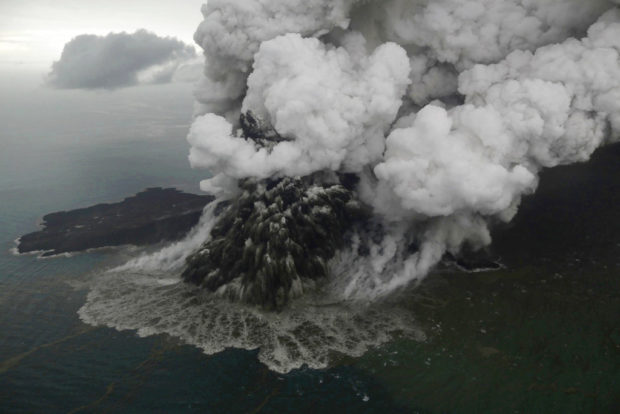Indonesia volcano shrinks to a third its size after eruptions

Credit to Author: besguerra| Date: Sun, 30 Dec 2018 03:06:54 +0000
JAKARTA — Mount Anak Krakatau in the Sunda Strait has shrunk to almost a third its original height, from 338 meters to 110 m, after a series of eruptions triggered a tsunami last week, killing more than 400 people and injuring thousands.
The Volcanology and Geological Disaster Mitigation Center (PVMBG) estimated that the volcano reduced to between 40 million and 70 million cubic meters in size from a mass of about 150 million to 180 million m3, following eruptions that occurred between Dec. 24 and 27,
“Given that the remaining volume is not too large, the potential for another tsunami is relatively small, unless there is a reactivation of faults or fault structure in the Sunda Strait,” PVMBG secretary Antonius “Purbo” Ratdomopurbo said on Saturday.
He said the reactivation would appear as an earthquake, which the authorities could not detect.
“We must be ready if a reactivation occurs.”
Purbo said the greatest potential danger from Anak Krakatau was a Surtseyan eruption, which takes place on the surface of the sea. This kind of eruption produces a lot of ash but cannot trigger a tsunami.
He added that based on the view from the Pasauran Volcano Observation Post, the cone of the volcano is currently situated lower than Sertung Island and Panjang Island, which are 182 m and 132 m above sea level.
“The status is still alert or level III. We won’t raise it to level IV because there are no inhabitants on Sertung Island and Panjang Island,” he said.
Thomas Giachetti, a volcanologist from the University of Oregon and one of four authors who published a 2012 study warning the possibility of a tsunami triggered by Anak Krakatau’s flank collapse, said: “It’s better to consider that the volcano is unstable and might collapse again.”
He noted that the cone of the volcano was particularly unstable because it was built on the rim of the emerged 1883 caldera, 150 to 200 m deep. To date, the exact volume and shape of the landslide on Saturday was also still unknown, preventing accurate modeling of landslides and related tsunamis, he said.
In the case of Surtseyan explosions, Giachetti wrote in his study: “Direct volcanic hazard related to the activity itself is indeed higher […] and this activity will persist until the lava accumulated build another emerged platform.
“Tsunami hazard related to the volcanic activity has not passed, the volcano should be watched almost permanently, and that observations at the volcano should be linked to a tsunami alert system.
“A functional buoy within the caldera of the 1883 eruption would definitely help detect another tsunami.”
Purbo said the cone of the volcano could reemerge as volcanic activity continues to occur.
“The volcano will emerge steadily because there are volcanic activities since the magma inside it will never disappear,” he said.